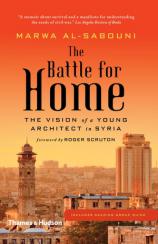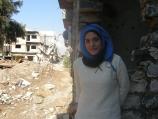Excerpt
Excerpt
The Battle for Home: The Vision of a Young Architect in Syria

Introduction
We in Syria have been in the news since 2011. The world has been watching us, and we have been watching ourselves, getting killed, tortured and uprooted. We have seen our buildings demolished, our cities destroyed and our archaeological treasures vandalized. These images have been on display so much that we rarely question why all this has happened. In politics and history, when narratives are assembled, parties tell their own sides of the story. It is only through architecture that we see the point of view that is no one’s in particular and everyone’s in general. Buildings do not lie to us: they tell the truth without taking sides. Every little detail in an urban configuration is an honest register of a lived story.
In this book, I try to show that in the built environment we can find not only indicators of events that have already occurred, but also portends of what could or might still occur. In addition, I try to show how architecture in my country has played a vital role in creating, directing and heightening conflicts between warring factions, by facilitating poor choices and narrowing viable alternatives. I write about the shape of settlements and related economic systems, the moral code inspired by the architecture of a place, and the ways in which architectural choices can determine questions of identity and home. Relating to another reason why I wrote this book, it should be noted that even in countries that seem to be distanced from our own misfortune in Syria (especially the other countries touched by the so-called Arab Spring), notions of identity and home are just as much in jeopardy.
The world has watched with anguish as ISIS has vandalized or threatened treasured sites, including Palmyra in Syria and the Assyrian towns in Iraq. It has witnessed the tragic destruction of the Old Souks of Aleppo and Homs, along with countless ancient buildings and relics caught in the crossfire. These losses, despite their severity, are of course incomparable to the human losses – the wasted and damaged lives of innocents, and the destruction of the social fabric – but they constitute further reasons for me to write this book: to consider the paths that have led to this ordeal and to shed light on the role played by the built environment. I suggest that the failure to create architecture that can constitute a home for its users stems from a loss of identity, which in turn has causes that go deep into the psychology of our people. When we look at what is being built in the Middle East today and how it is being built, this loss of identity becomes glaringly apparent, as does the jarring dis-connection between the rich heritage of the past and the empty modernism now being imported to form the present.
Grief over the violence that ISIS has perpetrated on ‘innocent’ ancient buildings can be viewed against reactions towards the mass destruction of entire cities. Why is it that ancient sites mean so much to all of us? Why is a scratch on a column in Palmyra of more consequence than the destruction of an entire concrete building? Furthermore, how was it that we vandalized our own cities in Syria before war came to deliver the final blows? And how should we rebuild what has been destroyed so that it will not happen again?
In searching for answers to these questions, I have lived a certain kind of life – not, to my mind, the easiest one. In telling the story of my city and the story of my country, I also tell my own story, in so far as it is relevant. I hope that the reader will learn something from these three stories that will help to avert in other places the kind of destruction that we have had to suffer here in Syria.
Homs, June 2015
Excerpted from THE BATTLE FOR HOME: The Vision of a Young Architect in Syria, by Marwa al-Sabouni
© 2016 Marwa al-Sabouni
Reproduced by permission of Thames & Hudson Inc, www.thamesandhudsonUSA.com
The Battle for Home: The Vision of a Young Architect in Syria
- Genres: Cultural Studies, Current Affairs, Memoir, Nonfiction
- paperback: 208 pages
- Publisher: Thames & Hudson
- ISBN-10: 0500292930
- ISBN-13: 9780500292938


